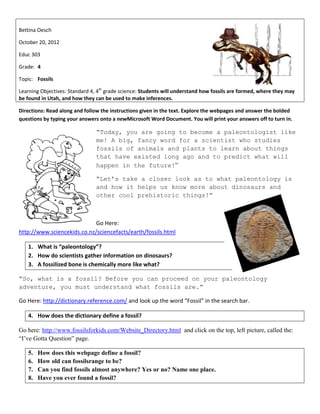
Web Qest on Fossils _ 4th Grade
- 1. Bettina Oesch October 20, 2012 Educ 303 Grade: 4 Topic: Fossils Learning Objectives: Standard 4, 4th grade science: Students will understand how fossils are formed, where they may be found in Utah, and how they can be used to make inferences. Directions: Read along and follow the instructions given in the text. Explore the webpages and answer the bolded questions by typing your answers onto a newMicrosoft Word Document. You will print your answers off to turn in. “Today, you are going to become a paleontologist like me! A big, fancy word for a scientist who studies fossils of animals and plants to learn about things that have existed long ago and to predict what will happen in the future!” “Let’s take a closer look as to what paleontology is and how it helps us know more about dinosaurs and other cool prehistoric things!” Go Here: http://www.sciencekids.co.nz/sciencefacts/earth/fossils.html 1. What is “paleontology”? 2. How do scientists gather information on dinosaurs? 3. A fossilized bone is chemically more like what? “So, what is a fossil? Before you can proceed on your paleontology adventure, you must understand what fossils are.” Go Here: http://dictionary.reference.com/ and look up the word “Fossil” in the search bar. 4. How does the dictionary define a fossil? Go here: http://www.fossilsforkids.com/Website_Directory.html and click on the top, left picture, called the: “I’ve Gotta Question” page. 5. How does this webpage define a fossil? 6. How old can fossilsrange to be? 7. Can you find fossils almost anywhere? Yes or no? Name one place. 8. Have you ever found a fossil?
- 2. “Now, adead body must go on a lengthy journey before it can reappear at the surface of the earth as a fossil. It is very rare that all the conditions are perfect for this strange fossilization process to happen. Let’s learn more about it!” Go Here: http://www.abc.net.au/beasts/fossilfun/ and explore the “Making Fossils” activity. Click on the red question mark circles and watch the simulations by clicking “next” button at the bottom. After going through each of the simulations, answer this question: 9. Are fossils easy to make? Yes or No? “Hopefully you now know more about fossils then you did before this adventure.Now, what do we do when we find fossils?” “Let’s say you are out digging up earth, looking for fossils. You come across a bunch of different fossils that all seem to belong to the same animal! Let’s test your skills and see if you can piece them together!...” Go Here: http://www.bbc.co.uk/sn/prehistoric_life/games/skeleton_jigsaw/ Click on the picture with the skeleton where is says “Open.” Select “Level 1” and drag the bones to where you think it fits in the picture. “Don’t give up!” 10. Which prehistoric animal(s) were you able to piece together? “Good Work! Paleontologists usually aren’t as fortunate as you are, onlyable to findbits and pieces of fossils scattered everywhere, or over LONG periods of time.” Go Here: http://www.fossilsforkids.com/Now_and_Then.html. Scroll down and see all the different pictures of fossils. Click on them to see who they belong to now and then. Find the fossil that belongs to a “Megalodon.” 11. What animal does a Megalodon most look like today? Go Here: http://www.prehistoric-wildlife.com/species/m/megalodon.html to see how big a Megalodon compares to a Great White Shark today. “Wow, it’s amazing to see how large some of these prehistoric animals used to be! Let’s see what other large figures we can find!”
- 3. Go Here:http://www.fossils-facts-and-finds.com/facts_on_fossils.html and read through the page about some of the biggest, oldest, longest fossils ever found! 12. Which dinosaur do scientists believe to be the largest ever? 13. What does its name mean? Is the name fitting? Go Here: http://sauroposeidon.files.wordpress.com/2010/04/wedel- cifelli-2005-oklahoma-giant.pdfDon’t be intimidated, just scroll down slowly and observe the pictures of this massive giant and its size. Did you see how big the Sauroposeidon’s footprint was? 14. Read the title. Where do you think this dinosaur was discovered? “Now, dinosaurs aren’t the only beasts to have roamed the earth. Up where it was colder, large Wooly Mammoths evolved. Today, we can see mammoths that have been miraculously preserved. Let’s learn more!” Go Here: http://www.youtube.com/watch?v=ZOFf1wyx91M and see an ancient beast perfectly preserved for yourself! “Are you finding this web adventure interesting? Maybe paleontology is the thing for you! Let’s learn more about what a paleontologists really does…”Go Here: http://www.youtube.com/watch?v=SEyl2rRa2YYand watch this short paleontologist YouTube video. 15. What 4 subjects to paleontologists have to study?
- 4. 16. Would you ever want to become a paleontologist?Why or why not? Extended Exploration (Not Required) “Perhaps you can take a trip with your family or friends and discover what Utah has to offer paleontologists!” Go Here: http://geology.utah.gov/utahgeo/dinofossil/fosguide/fosguide.htm to learn where you can find fossils in Utah… click on “Dinosaur Tracksites& Trails” to find more information! Go Here: http://www.utah.com/dinosaur/ to find places in Utah that offer dinosaurexploration! Go Here: http://www.u-digfossils.com/ to see how you can participate in the U-dig out west of the Great Salt Lake. Spring Break digs are being held in March! Perhaps you can enjoy this experience with your family.
- 5. Answer Key: 1. ”Paleontology is the branch of biology that studies the forms of life that existed in former geologic periods, primarily by studying fossils” 2. Collecting and examining fossils 3. Stone/Rock 4. “Any remains, impression, or trace of a living thing of a former geologic age, as a skeleton, footprint, etc” 5. “The remains or impressions of plant or animals that lived a very long time ago” 6. 10 thousand - 500 million years 7. Yes; (answers vary as to where) 8. Answers will vary 9. No 10. Answers will vary (should have a least a “Gastornis”) 11. Great White Shark 12. Sauroposeidon 13. “Earthquake God Lizard”; answers may vary 14. Oklahoma 15. Geology, Chemistry, Biology, Astronomy 16. Answers will vary Photo References: Dinosaur: http://www.ideacenter.org/stuff/contentmgr/files/bcb24ee3673f4b8ad933225507f654ed/image/lawn2_paleodino_sm.jpe Paleontologist Cartoon: http://www.printactivities.com/ColoringPages/Dinosaur_Coloring_Pages/Cartoon_Dinosaurs/Paleontologist.gif Shell: http://www.paleoportal.org/images/images/nautilus_home2_08.jpg Fossil Bug: http://farm4.static.flickr.com/3529/3792698748_09da9bf93d.jpg Gastornis fossil: http://upload.wikimedia.org/wikipedia/commons/2/27/Gastornis_skeleton.jpg Sauroposeidon: http://files.truedinos.webnode.com/200000757-7817c79110/Sauroposeidon3.jpg Museum: http://media.smithsonianmag.com/images/Dinosaur-Tracking-fossilized-Archaeopteryx-1.jpg Dino-tracks: